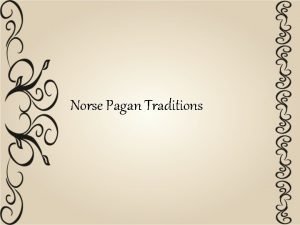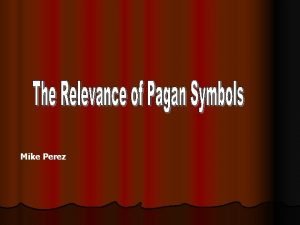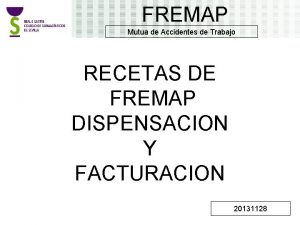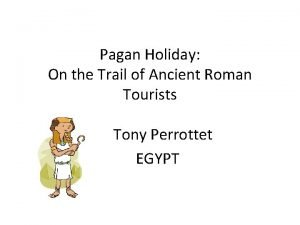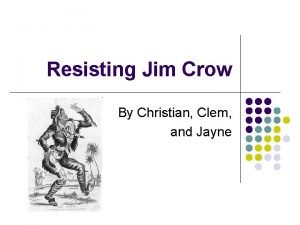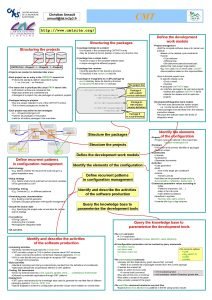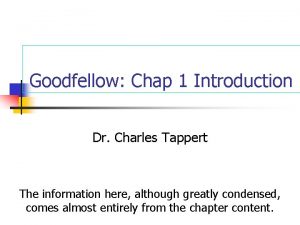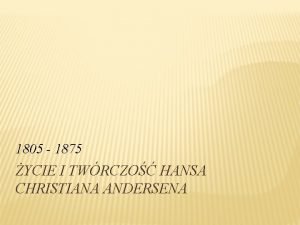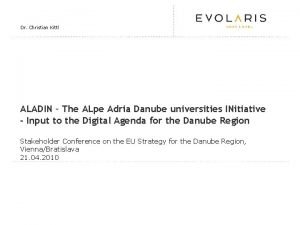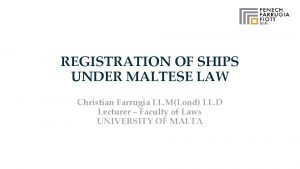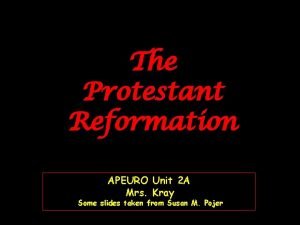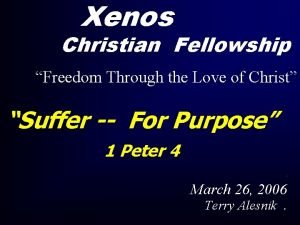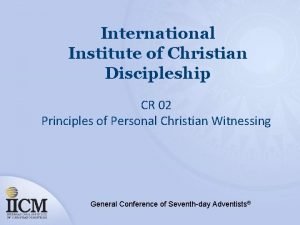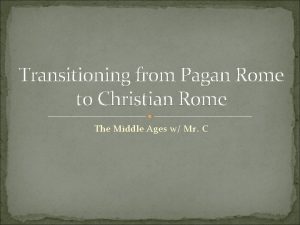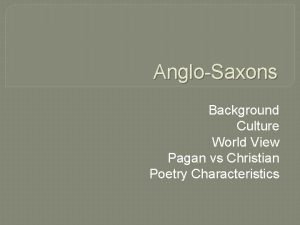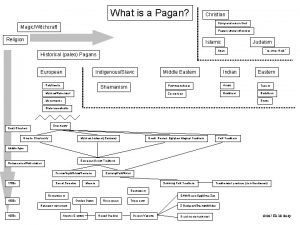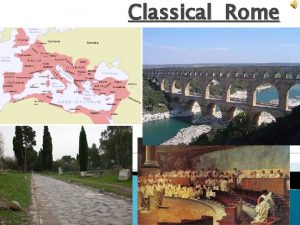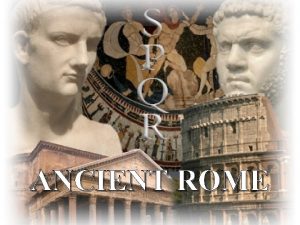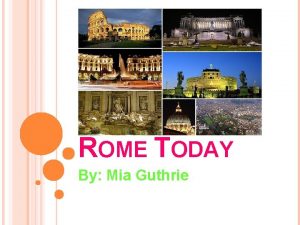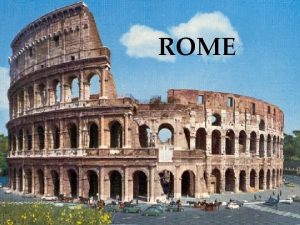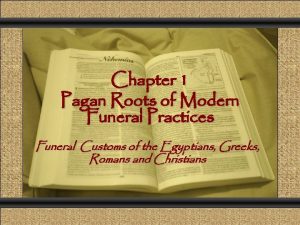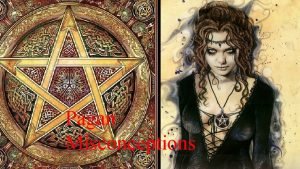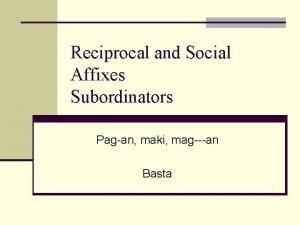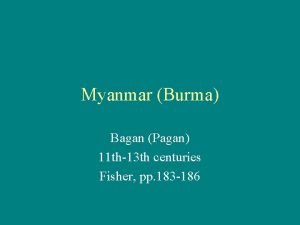From Pagan Rome to Christian Rome to the
































































- Slides: 64

From Pagan Rome, to Christian Rome, to the fall of Rome UB: IB Hist. w/ Mr. C Part I

Major Events: Tetrarchy

Diocletian Hard-headed but a successful soldier Saw the lack of a stable central authority Fixed it Powers & Privileges of the Senate disappeared or became meaningless Senate was reduced to basically a local city council. Empire was governed by laws but the emperor was the source for all laws

Diocletian The carefully designed political system changed: Augustus concealed his political dictatorship Gaius Julius Octavius – later Octavius Caesar Augustus was an honorific: majestic, venerable Pontifex Maximus Princeps senatus pater patriae Ecetera But never imperator Diocletian sets up an overt, divine-right monarchy based on the eastern model.

divine-right monarchy Oriental mystique justifies imperial absolutism The emperor becomes a god on earth Later after Christianity is accepted this is modified as the divinely ordained representative A sacred figure set far above humanity Became an Eastern god-king Basileus / βασιλεύς On official occasions jeweled robes, tiara, scepter People would prostrate themselves

Diocletian Builds a palace in Nicomedia Much power is transferred to the Great Chamberlain Typically a eunuch in the eastern tradition Also reorganizes the power of subordinate rulers Previously the governor was also the head general Now civilian & military chain of command is seperated Civilian command – Praetorian Prefect Military command – Magister Militum

Major Events: Theodosius I's Empire 395 AD Theodosius I was the last Emperor to rule both parts of the Roman Empire.

Pressures leading to Rome’s fall Diocletian and Constantine coped sucessfully with short term financial woes and administrative problems from the civil wars of the mid 3 rd century (250’s AD). But it was a short term gain.

Early Christian Church & Hellenistic Culture The ancient religion of Rome Little emotional content Services performed for gods so they would show favor Business bargain/contract quid quo pro – this for that Many gods were borrowed: Greek Egyptian Middle-East/”Orient” oriens – east in Latin Originally, the term referred to Egypt, the Levant, and adjoining areas.

Early Christian Church & Hellenistic Culture Greek Iupiter (Optimus Maximus) – aka, Jupiter or Zeus Mars – Ares, the god of war Venus – Aphrodite, the goddess of love ecetera – Latin for “and all the rest” Egyptian Isis married her brother, Horus, and helped raise her son, Osiris, back from the dead when he was killed by his brother, Set. Middle-East/”Orient” Cybele was known as Magna Mater ("Great Mother"). Sol Invictus ("Unconquered Sun") was the official sun god of the later Roman Empire and a patron of soldiers.

Early Christian Church & Hellenistic Culture Roman religion was NOT exclusive. The gods of Gauls & Brits were added and mixed with an existing god, or given their own place if new. Always a problem with the Jews and their Yahweh Later a problem with the Christians and their Jesus They did not, nor intended to, inspire people to a high moral standard or teach them purpose. Remember, this was a business deal. Many people felt a yearning for truth and goodness This is based on the widespread appeal of alternative philosophies and religions that we see in the records.

Early Christian Church – Intermarriage Marriage between a Christian and pagan is forbidden. Although some argue that such marriages are indirectly supported the Pauline privilege in 1 Corinthians 7: 12– 14: "For the unbelieving husband is sanctified through his (believing) wife, and the unbelieving wife is sanctified through her believing husband. " I would argue that St. Paul said this to couples that were already married. Imagine the situation, married couple, one converts, do they now divorce their spouse if they refuse to convert?

Early Christian Church & Pagans For some Pagans, they were okay with Christianity. Similarities to mystery religions? Death and rebirth Cybylene - Syria Mythra – Persia Osiris – Egypt Cleansing one from sin and leading a virtuous life. Some type of everlasting life promise. Some Romans entered almost ALL of the cults. They were like Pokemon! Differences?

Early Christian Church & Pagans Differences? Jewish tradition of Monotheism Mono= 1 in Greek, Theo= God in Greek Immediate and concrete origin Jesus was a real person who lived fairly recently. Simple Love God. Love your neighbor. Complex God is love. The Kingdom of Heaven is within you. One Single God: Three Personae Three roles: Father, Son, & Holy Ghost

Early Christian Church - Basics NOT TRYING TO CONVERT ANYONE! One single God. Human nature flawed and corrupt with the first sin of disobediance. God promised a Messiah. The Redeemer appeared during the reign of Augustus Caesar. God the Son became incarnate in the man, Jesus, born of the Virgin Mary. Jesus proves his divinity through miracles.

Early Christian Church - Basics NOT TRYING TO CONVERT ANYONE! Mark 12: 30 -31 And thou shalt love the Lord thy God, with thy whole heart, and with thy whole soul, and with thy whole mind, and with thy whole strength. This is the first commandment. 31 And the second is like to it: Thou shalt love thy neighbor as thyself. There is no other commandment greater than these. 30 Not just an external observance, but an inner change of heart and overflowing charity towards others.

Early Christian Church - Basics NOT TRYING TO CONVERT ANYONE! 1 John 3: 17 -18 He that hath the substance of this world, and shall see his brother in need, and shall shut up his bowels from him: how doth the charity of God abide in him? 18 My little children, let us not love in word, nor in tongue, but in deed, and in truth. 17 Not just an external observance, but an inner change of heart and overflowing charity towards others.

Early Christian Church - Basics Compare and contrast with the standard Roman prayer: To the gods above and the gods below, and all the ones I do not know, whether you be god or goddess, in return for my sacrifice grant me… Remember! Roman pagan prayers were phrased like legal documents that could obligate gods for particular action and protection. Public religious ritual had to be enacted by specialists and professionals faultlessly; a mistake might require that the action, or even the entire festival, be repeated from the start.

Medieval Church - Basics NOT TRYING TO CONVERT ANYONE! Eventually the Medieval Church (Catholic) will build a whole structure of sacramental theology on the basis of these scriptures, specifically: Matt. 16: 18 & 18: 18 And I say to thee: That thou art Peter; and upon this rock I will build my church, and the gates of hell shall not prevail against it. 18 Amen I say to you, whatsoever you shall bind upon earth, shall be bound also in heaven; and whatsoever you shall loose upon earth, shall be loosed also in heaven. 18

Medieval Church - Basics NOT TRYING TO CONVERT ANYONE! Eventually the Medieval Church (Catholic) will build a whole structure of sacramental theology on the basis of these scriptures, specifically: Matt. 26: 26 -28 And whilst they were at supper, Jesus took bread, and blessed, and broke: and gave to his disciples, and said: Take ye, and eat. This is my body. 27 And taking the chalice, he gave thanks, and gave to them, saying: Drink ye all of this. 28 For this is my blood of the new testament, which shall be shed for many unto remission (forgiveness) of sins. 26

Early Christian Church – Persecution Given what we’ve covered on philosophy, pagan Roman religions & traditions, and early Christianity… … WHICH IS A LOT! …It’s obvious there would be no problems. <sarc/> As Christianity spreads, it encounters scornful hostility from pagan intellectuals. WATCH THE VIDEO(S) ON THE WEBSITE!!!

Early Christian Church – Persecution Calligula (37 -41 AD) In his defense, he was crazy. He kills some, not as much as. . Nero (54 -68 AD) Fire in Rome? Umm, it was the Christians! Marcu Aurelius (121 -180 AD) Yes, even the last of the “good Emperors”! Persecutions increase under him. Diocletian Great Persecution – Do you think it was bad? Ordered that the deacon Romanus of Caesarea have his tongue removed for defying the order of the courts

Early Christian Church – Persecution Difficulties for Educated Pagans Miracles? That’s okay. Resurrection? No problem.

Early Christian Church – Persecution Difficulties for Educated Pagans Miracles? That’s okay. Resurrection? No problem.

Early Christian Church – Persecution Difficulties for Educated Pagans Miracles? That’s okay. Resurrection? No problem. Executed as a criminal, displacing all other gods, having simple teachings instead of using elegant myths or nuanced arguments.

Early Christian Church – Persecution Difficulties for Educated Pagans Miracles? That’s okay. Resurrection? No problem. Executed as a criminal, displacing all other gods, having simple teachings instead of using elegant myths or nuanced arguments.

Early Christian Church – Persecution To many pagan intellectuals it was a perverse and irrational cult. Celebration of the Eucharist? Cannablism. Christian love? Unrestrained licentiousness. In the words of one critic: They know one another by secret marks and signs and they love one another almost before they know one another… there is a religion of lust among them… their vain and sensless superstition glories in crime. The real problem with Christianity lies in the reality that pagans found it could not be assimilated the way other religions had been; thus it was a danger to the state – in their eyes.

Early Christian Church – Triumphant So what changes?

Early Christian Church – Triumphant Constantine – watch the video Battle of the Milvian Bridge Attacking Maxentius in Rome. Maximin is in the east. Constantine & Licinius will kick his butt later. 312 AD"(ἐν) τούτῳ νίκα“ (In hoc signo vinces) In this sign, conquer. 313 AD Edict of Milan issued by Emperors Constantine the Great and Licinius; Christianity was legalized. Greek letters: X (chi) P (rho) first two letters of Χριστός – Christ

Early Christian Church – Triumphant Constantine: Christianity transformed from a persecuted sect to the favored religion of the Empire. Modern historians are skeptical and look for reasons. But there is no good reason for him to convert. Christians not popular Not represented in the army Safe to say Constantine believed in the Christian God [I was] “brought to the faith by God to be the means of the faith’s triumph. ”

Early Christian Church – Triumphant Rights under Constantine: Receive legacies (endowments/inheritance) Freedom from taxes Legal jurisdiction (cannon law) Sanctuary All of Constantine’s successors, save one – Julian (361 - 363 AD) were Christian.

FINAL BIG IDEA Constantine becomes the sole Emperor in 324 AD. In the east, a religious controversy has started. Arianism – Arius a priest in Alexandria The Son, the logos, had not existed from all eternity but was created by the one God who alone was eternal. Constantine decides to settle it once and for all by calling all the bishops together to discuss it. Previously, local groups of bishops would settle disputes. He makes all the traveling facilities of the imperial postal service at their service. Constantine creates a new institution of Church

FINAL BIG IDEA – Council of Nicea Produces a definition of doctrine and condemns Arianism. The Son is of “one substance with the Father”. Later becomes the Nicene Creed. This argument will continue on in the churches in the east for several decades. It is not finally settled until Theodosius I (379 -95 AD). Theodosius I supports the Nicene Creed. He called for another council. The Council of Constantinople (381 AD) Reaffirms the doctrine of Nicea.

FINAL BIG IDEA – Council of Nicea It is important to know: 1. This debate has bishops eventually arguing with the Emperor over interference in Church matters 2. This matter is not settled in the east until the Emperor steps in. This will have lasting ramifications.

The Barbarian Invasions Were they “Barbarians”?

The Barbarian Invasions Were they “Barbarians”? Of course they were! Barbarian in Greek = βάρβαρος Definition: “foreign, strange” onomatopoeic (mimicking foreign languages, 'blah') Barbarian in Latin = barbarus The borders of the Roman Empire did not keep foreigners out very well. FOURTH CENTURY (300 -399 A. D. ) And we should all know A. D. stands for: And it means:

The Barbarian Invasions Were they “Barbarians”? Of course they were! Barbarian in Greek = βάρβαρος Definition: “foreign, strange” onomatopoeic (mimicking foreign languages, 'blah') Barbarian in Latin = barbarus The borders of the Roman Empire did not keep foreigners out very well. FOURTH CENTURY (300 -399 A. D. ) And we should all know A. D. stands for: Anno Domini And it means: In the year of our Lord. We do not really have a “pure Roman” world and a “pure Barbarian” world.

Germanic People Teuton/Teutonic: A tribe known in Latin as the Teutones. The term "Teutons" also may refer to the Germanic peoples collectively or the Germans in particular. ~500 B. C. Germanic people begin to migrate from their northern homelands. By ~100 B. C. they begin to occupy “Germany” Formerly the land of the … ANYONE CARE TO GUESS?

Germanic People Teuton/Teutonic: A tribe known in Latin as the Teutones. The term "Teutons" also may refer to the Germanic peoples collectively or the Germans in particular. ~500 B. C. Germanic people begin to migrate from their northern homelands. By ~100 B. C. they begin to occupy “Germany” Formerly the land of the Celts. Julius Caesar writes about them in 50 B. C. Other German peoples follow: The general trend is south and west though some go south and east, establishing themselves in southern Russia.

Roman Empire – 125 A. D.

Germanic Migrations – 21 to 700 A. D. my. fit. edu

Germanic Migrations - Völkerwanderung http: //www. onb. ac. at/ausb/pro 2/pt 4/karte. jpg

Germanic People Sparse evidence. Some Roman writers – Tacitus Archaeology & Anthropology Clues left behind in the German language Pastoral Does this word make you think of anything? ? ?

Germanic People Sparse evidence. Some Roman writers – Tacitus Archaeology & Anthropology Clues left behind in the German language Pastoral They lived on the produce of their flocks and herds. butter, cheese, meat Knew how to work iron, but small supplies of the metal. Typically used bronze, wood, leather How is bronze made?

Germanic People Sparse evidence. Some Roman writers – Tacitus Archaeology & Anthropology Clues left behind in the German language Pastoral They lived on the produce of their flocks and herds. butter, cheese, meat Knew how to work iron, but small supplies of the metal. Typically used bronze, wood, leather How is bronze made? Alloy of copper and tin. 9: 1 ratio Brass is an alloy of Copper and Zinc; 7: 3 ratio

Germanic People Agriculture Ox drawn plough if they had to. Primarily they hunted. Favorite pursuits: Hunting Fighting Plundering

Germanic People Political system ANYONE CARE TO GUESS?

Germanic People Political system Tribal Chieftain, strong kinship ties

Germanic People Remember, this will be on the exam. There were aproximately 16 Germanic Tribes: Alans, Angul(Angels), Aurvandil (Vandals), Burgundus (Burgundians), Cibidus(Cibidi), Dan (Danes), Franks, Gepids, Gothus(Goths), Ingve (Ynglings), Irmin (Irminones), Longobardus (Lombards), Nór (Norwegians), Normans (partial Germanic peoples), Ostrogoths, Rugians, Saxneat (Saxons), Sciri, Teutoni, Valagothus (Valogoths), and Visigoths.

Germanic People Remember, this will be on the exam. There were aproximately 16 Germanic Tribes: Alans, Angul(Angels), Aurvandil (Vandals), Burgundus (Burgundians), Cibidus(Cibidi), Dan (Danes), Franks, Gepids, Gothus(Goths), Ingve (Ynglings), Irmin (Irminones), Longobardus (Lombards), Nór (Norwegians), Normans (partial Germanic peoples), Ostrogoths, Rugians, Saxneat (Saxons), Sciri, Teutoni, Valagothus (Valogoths), and Visigoths. Kidding. BUT you should know the main ones.

The Barbarian Invasions Ever since the last century before Christ the Roman world and the barbarian world have influenced each other.

The Barbarian Invasions EXAMPLES? German Slaves & coloni (colonist, settler OR farmer) German fighters Joined as individuals or formed German units a. k. a. foederatti (allies) Fought under their own Chieftain Amount of assimilation depended on proximity and receptivity

The Barbarian Invasions ALSO depended on other factors: Two Roman provinces had been from the beginning a blend of: WHAT TWO CULTURES: ? ? ? LOCATED WHERE: ? ? ? Goths were Christianized by Empire in the East

The Barbarian Invasions ALSO depended on other factors: Two Roman provinces had been from the beginning a blend of: WHAT TWO CULTURES: Roman & Celtic LOCATED WHERE: Gaul & Britain So was it that ‘weird’ to have these German Barbarians? Goths were Christianized by Empire in the East

The Barbarian Invasions Trade between the R. E. & βάρβαρος Βάρβαρος give cattle and slaves (Where do you think the slaves come from? Hmmm? ) R. E. gives glass & bronze vessels, ornaments, weapons, textiles

The Barbarian Invasions GRADUALLY Western provinces were “Germanized” Germanic people were “Romanized” This would have went faster BUT… The frontier went through periods of war and peaceful trading Regardless, the Germans were always pushing on the border Angles & Saxons travel to Britain, Franks occupy the borderlands

Byzantine Civilization We will not have time to get in depth here. Important ideas: Asia Minor, Syria, Palestine, & Egypt remain untouched by the German barbarian hordes. When Romulus Augustus (475 -476 AD) the last emperor in the West is deposed, Zeno (474 -491 AD) continued to rule in the East. Byzantine culture shows a tenacity for survival. In times of crisis, an able ruler would pop up. Is a mixture of Hellenic and Oriental elements. The west is a mixture of barbarian (Germanic & Celtic), Catholicism, and Roman civilization.

Byzantine Civilization – major rulers Justinian (527 -565 AD) Tries to reclaim some of the West. Institutes the Justinian Code. Rules during a plague, care to guess the name?

Byzantine Civilization – major rulers Justinian (527 -565 AD) Tries to reclaim some of the West. Builds the Hagia Sophia (Great Church). Institutes the Justinian Code. Roman law had constantly changed and grew. American examples? Known collectively as jus vetus. From the 4 th century on (301 -400 AD) all laws were from Imperial edict. 528 issues the Codex Justinianus, complied completely of the jus novum. 530 starts on the jus vetus. 50 volumes: Digest. And writes one himself to be used as a textbook, Institutes. Why does this matter?

Byzantine Civilization – major rulers Justinian (527 -565 AD) Institutes. Justinian was an autocratic ruler. What does that mean? But the legal texts of the earlier period declared that the power of the emperor came from the people and that even the emperor was expected to rule in accordance with the law. Why is that important?

Byzantine Civilization – major rulers Mr. C’s email. nemo est supra legis sic semper evello mortem tyrannis nemo est supra legis sic semper tyrannis _ _ sic semper evello mortem tyrannis

Byzantine Civilization – major rulers Mr. C’s email. nemo est supra legis sic semper evello mortem tyrannis nemo est supra legis Nobody is above the law. sic semper tyrannis Thus always to tyrants The phrase is sometimes said to have originated with Marcus Junius Brutus during the assassination of Julius Caesar on 15 March 44 BC, but according to Plutarch, Brutus either did not have a chance to say anything, or if he did, no one heard what was said. sic semper evello mortem tyrannis Thus always I pluck death from tyrants. Thus always death to tyrants.

Byzantine Civilization – major rulers Justinian (527 -565 AD) Rules during a plague, care to guess the name?

Byzantine Civilization – major rulers Justinian (527 -565 AD) Rules during a plague, care to guess the name? Good job, it’s the Justinian Plague. Ἁγία Σοφία, "Holy Wisdom" Minarets were added after the Turkish/Muslim conquest in 1453.
 Simone pagan griso
Simone pagan griso Norse pagan wallpapers
Norse pagan wallpapers Xpictoc
Xpictoc Dr pagan pambudi
Dr pagan pambudi Easter pagan goddess
Easter pagan goddess Modelo parte de accidente de trabajo fremap
Modelo parte de accidente de trabajo fremap Roman pagan holidays
Roman pagan holidays Mật thư anh em như thể tay chân
Mật thư anh em như thể tay chân Tư thế ngồi viết
Tư thế ngồi viết Thẻ vin
Thẻ vin Thơ thất ngôn tứ tuyệt đường luật
Thơ thất ngôn tứ tuyệt đường luật Frameset trong html5
Frameset trong html5 Các châu lục và đại dương trên thế giới
Các châu lục và đại dương trên thế giới Hươu thường đẻ mỗi lứa mấy con
Hươu thường đẻ mỗi lứa mấy con Từ ngữ thể hiện lòng nhân hậu
Từ ngữ thể hiện lòng nhân hậu Diễn thế sinh thái là
Diễn thế sinh thái là Thế nào là giọng cùng tên? *
Thế nào là giọng cùng tên? * Glasgow thang điểm
Glasgow thang điểm Vẽ hình chiếu vuông góc của vật thể sau
Vẽ hình chiếu vuông góc của vật thể sau 101012 bằng
101012 bằng Lời thề hippocrates
Lời thề hippocrates đại từ thay thế
đại từ thay thế Quá trình desamine hóa có thể tạo ra
Quá trình desamine hóa có thể tạo ra Bổ thể
Bổ thể Cong thức tính động năng
Cong thức tính động năng Thế nào là mạng điện lắp đặt kiểu nổi
Thế nào là mạng điện lắp đặt kiểu nổi Dạng đột biến một nhiễm là
Dạng đột biến một nhiễm là Vẽ hình chiếu đứng bằng cạnh của vật thể
Vẽ hình chiếu đứng bằng cạnh của vật thể Hát lên người ơi
Hát lên người ơi Nguyên nhân của sự mỏi cơ sinh 8
Nguyên nhân của sự mỏi cơ sinh 8 độ dài liên kết
độ dài liên kết Sự nuôi và dạy con của hổ
Sự nuôi và dạy con của hổ Thiếu nhi thế giới liên hoan
Thiếu nhi thế giới liên hoan điện thế nghỉ
điện thế nghỉ Tỉ lệ cơ thể trẻ em
Tỉ lệ cơ thể trẻ em Một số thể thơ truyền thống
Một số thể thơ truyền thống Trời xanh đây là của chúng ta thể thơ
Trời xanh đây là của chúng ta thể thơ Bảng số nguyên tố lớn hơn 1000
Bảng số nguyên tố lớn hơn 1000 đặc điểm cơ thể của người tối cổ
đặc điểm cơ thể của người tối cổ Fecboak
Fecboak Các môn thể thao bắt đầu bằng tiếng bóng
Các môn thể thao bắt đầu bằng tiếng bóng Các châu lục và đại dương trên thế giới
Các châu lục và đại dương trên thế giới Hát kết hợp bộ gõ cơ thể
Hát kết hợp bộ gõ cơ thể Thế nào là hệ số cao nhất
Thế nào là hệ số cao nhất ưu thế lai là gì
ưu thế lai là gì Sơ đồ cơ thể người
Sơ đồ cơ thể người Tư thế ngồi viết
Tư thế ngồi viết Gấu đi như thế nào
Gấu đi như thế nào Cái miệng bé xinh thế chỉ nói điều hay thôi
Cái miệng bé xinh thế chỉ nói điều hay thôi Christian clem
Christian clem Dr. christian berthold
Dr. christian berthold Christian arnault
Christian arnault Martin härterich
Martin härterich Christian tappert
Christian tappert Hans christian andersen życiorys
Hans christian andersen życiorys Christian leadership qualities
Christian leadership qualities Christian kittl
Christian kittl Christian leadership concepts
Christian leadership concepts Christian farrugia
Christian farrugia Christian vs catholic
Christian vs catholic Suffer not the xenos to live
Suffer not the xenos to live Metro manila christian church
Metro manila christian church Oikos
Oikos Verhaltenstherapie-breitenlee
Verhaltenstherapie-breitenlee Thomas knigge
Thomas knigge

